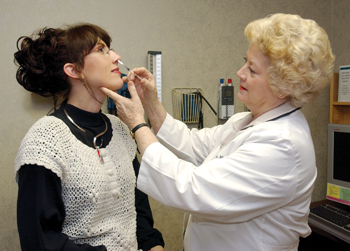
Debi Darnell, an administrative assistant in the Department of Radiology and Radiological Sciences, is given the FluMist vaccine by Helen Scott, R.N., at the Occupational Health Clinic.
photo by Dana Johnson
Myths about FluMist outrunning the facts
Vanderbilt University Medical Center now has enough FluMist, the nasal spray form of influenza vaccine, on hand to protect much of its workforce from the flu.
Thus far, staff of the Occupational Health Clinic have administered more than 1,800 doses of FluMist to VUMC personnel without any reported adverse reactions other than a few runny noses. Despite this progress, a significant number of employees who are eligible have declined to receive FluMist, citing one or more incorrect notions about the vaccine.
Incorrect information about FluMist has reached urban-legend status in some areas of the Medical Center. Rumors persist of an unnamed, apocryphal staff member who received FluMist, developed flu from the vaccine, then went home sick for several days. “If anyone can produce this person we'd like to meet them,” said William Schaffner, M.D., professor and chairman of the Department of Preventive Medicine, and an internationally known expert on influenza. “This instance would be a reportable case to the State Department of Health and the Centers for Disease Control and Prevention.”
The following factual information about FluMist is provided by Melanie Swift, M.D., assistant professor of Medicine and medical director of the Vanderbilt Occupational Health Clinic, and Thomas Talbot, M.D., assistant professor of Medicine and Preventive Medicine and associate hospital epidemiologist, who wish to assure all VUMC employees this form of flu vaccine is effective and safe for both those who receive it and their patients.
Myth: “You can get the flu from FluMist.”
Fact: You cannot get the flu from a FluMist vaccination. FluMist is a live, attenuated virus that cannot replicate at body temperature and cannot cause the flu.
While FluMist consists of a live form of influenza virus given through the nose, it has been weakened so that it cannot cause infection. First, many of the viral virulence factors have been altered, removing its ability to cause infection. Secondly, the FluMist virus cannot reproduce at temperatures above 37-39 degrees Celsius, the temperature of human lungs and lower airway. The FluMist virus cannot survive in lungs, bloodstream, or deeper parts of the body.
Myth: “FluMist virus can be easily spread by me to others making them sick.”
Fact: It is harder than it seems to transmit the vaccine virus.
A concern with the use of FluMist has been the worry that vaccine virus can be spread from a FluMist recipient to others, particularly those with weakened immune systems. This concern is greatly over estimated, since several unlikely events would need to occur in order for a FluMist recipient to spread virus that then causes a clinical infection in others:
• The person must shed the virus from their nose.
• The amount of virus shed would need to be large enough to cause spread of infection.
• If the FluMist virus is spread to another person, it must become able to reproduce in the temperature of the lower airways.
• After the first three steps occur then the FluMist virus would have to regain its ability to cause disease.
There have been no instances of symptomatic transmission of the vaccine virus in adults. The only documented case of person-to-person transmission of the FluMist virus occurred when one child transmitted virus to another at daycare where there was prolonged close contact. The second child did not develop symptomatic infection. Finally, there has never been an instance where the FluMist virus has regained its ability to reproduce at higher temperatures or to cause infection. Thus, there is no likelihood that vaccination with FluMist would cause a flu-like infection.
Myth: “I should not take FluMist because I live or work in close contact with an unvaccinated person at high-risk to develop influenza.”
Fact: Household contacts of high-risk individuals help to protect that person by getting vaccinated. You are not helping your high-risk loved one by foregoing vaccination. It is safe for FluMist recipients to have close household contact with high-risk individuals with the sole exception of those so severely immunosuppressed that they require a special protective environment (i.e. patients with a stem cell transplant receiving care on a positive-pressure hospital ward).
It is safe for FluMist recipients to have close household contact with high-risk individuals with chronic illnesses, including diabetes, liver disease, heart disease, and even other forms of immunosupression such as HIV-infected patients and organ transplant recipients.
Myth: “FluMist makes everyone who gets it sick in some way.”
Fact: There is a higher rate of certain cold symptoms following vaccination with FluMist, such as a runny nose, but many people report no symptoms at all.
In studies comparing FluMist with a placebo vaccine, there were no differences in the frequency of reported cough, runny nose, sore throat, muscle aches, fever, chills, or decreased activity in children. A small number of adults who have received FluMist do report a slightly greater frequency of runny nose, sore throat, and nasal congestion, but there were no differences in the number of reported flu-like illnesses between the two groups. While people may report a flu-like illness after receiving FluMist, remember that many respiratory “cold” viruses that can cause a flu-like illness circulate in the winter months. FluMist, and the flu shot for that matter, do not cause influenza.













